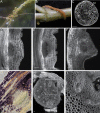A roadmap of haustorium morphogenesis in parasitic plants
- PMID: 37486862
- PMCID: PMC10752351
- DOI: 10.1093/jxb/erad284
A roadmap of haustorium morphogenesis in parasitic plants
Abstract
Parasitic plants invade their host through their invasive organ, the haustorium. This organ connects to the vasculature of the host roots and hijacks water and nutrients. Although parasitism has evolved independently in plants, haustoria formation follows a similar mechanism throughout different plant species, highlighting the developmental plasticity of plant tissues. Here, we compare three types of haustoria formed by the root and shoot in the plant parasites Striga and Cuscuta. We discuss mechanisms underlying the interactions with their hosts and how different approaches have contributed to major understanding of haustoria formation and host invasion. We also illustrate the role of auxin and cytokinin in controlling this process.
Keywords: Cuscuta; Striga; Auxin; cytokinin; haustoria; host; invasion; lateral roots; parasitic plant.
© The Author(s) 2023. Published by Oxford University Press on behalf of the Society for Experimental Biology. All rights reserved. For permissions, please email: journals.permissions@oup.com.
Conflict of interest statement
The authors declare no conflict of interest.
Figures



References
-
- Aoki N, Cui S, Yoshida S.. 2022. Cytokinins induce prehaustoria coordinately with quinone signals in the parasitic plant Striga hermonthica. Plant and Cell Physiology 63, 1446–1456. - PubMed
-
- Benková E, Michniewicz M, Sauer M, Teichmann T, Seifertová D, Jürgens G, Friml J.. 2003. Local, efflux-dependent auxin gradients as a common module for plant organ formation. Cell 115, 591–602. - PubMed
-
- Berner DK, Kling JG, Singh BB.. 1995. Striga research and control—a perspective from Africa. Plant Disease 79, 652–660.
-
- Cai T, Babiker AG, Ejeta G, Butler LG.. 1993. Morphological response of witchweed (Striga asiatica) to in vitro culture. Journal of Experimental Botany 44, 1377–1384.
Publication types
MeSH terms
Substances
Grants and funding
LinkOut - more resources
Full Text Sources

